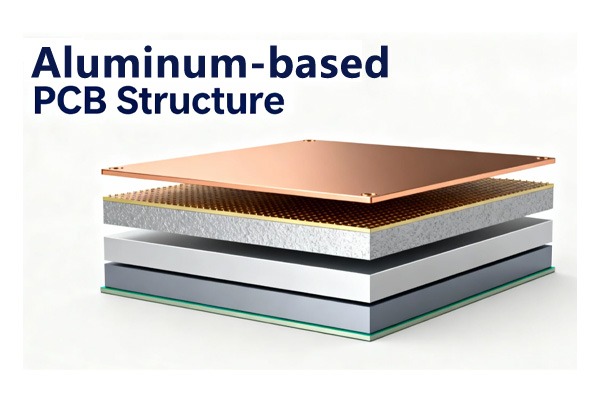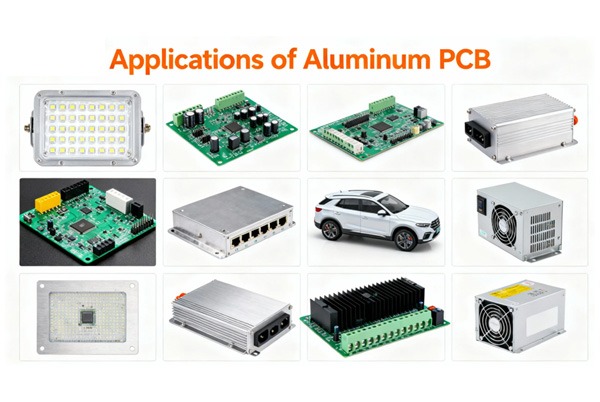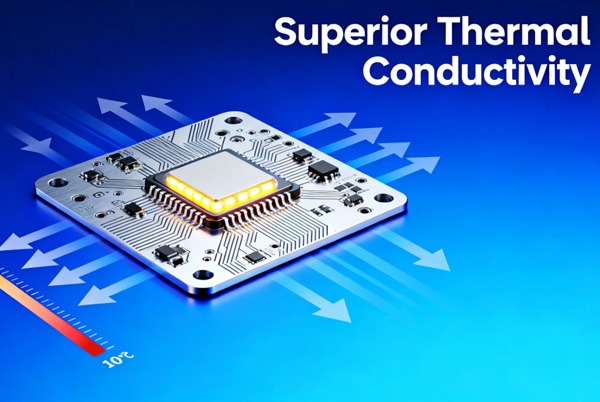Table of Contents
Definition of Aluminum-Based PCB
Aluminum-based PCBs (aluminum printed circuit boards) are metal-clad circuit boards that use aluminum alloy as the base substrate material, replacing the epoxy resin fiberglass substrate of traditional PCBs. This special structure makes them an ideal thermal solution for high-power electronic devices, particularly suitable for high-heat applications like high-power LED lighting, automotive electronic control systems, and industrial power equipment.
The thermal conductivity of aluminum-based PCBs typically reaches 160-200 W/m·K, which is over 500 times higher than that of traditional FR-4 material (0.2-0.3 W/m·K). This effectively reduces the operating temperature of components and significantly extends device service life.
Three-layer structure of aluminum-based PCBs
1. Circuit Layer (Copper Foil Layer)
- Material: High-purity electrolytic copper foil (typically 1oz-4oz thick)
- Function: Forms electrical connection circuits and carries electronic components
- Process: Precision circuit patterns formed through etching
2. Insulation Layer (Dielectric Layer)
- Material: Special epoxy resin or polyimide filled with ceramic powder
- Function: Provides both electrical insulation and thermal conduction
- Characteristics: Breakdown voltage >2kV, thermal conductivity 1-10 W/m·K
3. Metal Base Layer (Aluminum Substrate)
- Material: Aluminum alloys such as 5052, 6061
- Function: Mechanical support and core heat dissipation
- Characteristics: Density ~2.7g/cm³, balancing strength and weight
Aluminum-Based PCB vs. Traditional FR-4 PCB
| Characteristic Parameter | Aluminum-Based PCB | Traditional FR-4 PCB |
|---|---|---|
| Thermal Conductivity | 160-200 W/m·K | 0.2-0.3 W/m·K |
| Coefficient of Thermal Expansion | Matches chips | Mismatched, thermal stress must be considered |
| Mechanical Strength | High, vibration-resistant | Medium, prone to cracking |
| Weight Comparison | Lightweight design | Relatively heavier |
| Cost Analysis | 30%-50% higher | Lower cost |
| Suitable Power Level | High-power applications | Low to medium power applications |

Six Core Advantages of Aluminum-Based PCBs
1. Exceptional Thermal Performance
The metal base enables efficient heat conduction. A 1mm thick board can dissipate 3W/cm² of heat under natural cooling conditions, 6 times better than FR-4 substrates. In LED applications, this can reduce chip junction temperature by 25°C, extending lifespan from 30,000 hours to 50,000 hours.
2. Excellent Mechanical Stability
The aluminum alloy substrate provides high-strength support with superior vibration and impact resistance, suitable for harsh environments like automotive electronics.
3. Environmental Sustainability
Aluminum material is 100% recyclable, complies with RoHS environmental standards, and produces no toxic emissions during manufacturing.
4. Lightweight Structural Design
With a density of only 2.7g/cm³, aluminum provides structural strength while enabling lightweight designs, particularly suitable for portable devices and automotive electronics.
5. Good Dimensional Stability
Low deformation rate under temperature variations ensures accurate positioning of precision components.
6. Extended Component Lifespan
Excellent thermal management prevents component damage from overheating, increasing overall device lifespan by over 30%.
Main Application Areas of Aluminum-Based PCBs
LED Lighting Solutions
- High-power LED lamps: Street lights, industrial and mining lights, landscape lighting
- Automotive lighting: Headlights, daytime running lights, interior lighting
- Commercial displays: LED advertising screens, backlight modules
Automotive Electronic Systems
- Powertrain control systems: Engine ECU, transmission control
- Safety systems: ABS controllers, airbag systems
- New energy vehicles: Battery management systems, DC-DC converters
Power Electronic Equipment
- Switch-mode power supplies: Server power supplies, industrial power supplies
- Inverter systems: Solar inverters, UPS uninterruptible power supplies
- Motor drives: Industrial frequency converters, servo drives
Communication and Consumer Electronics
- 5G communication equipment: Base station power amplifiers, RF modules
- High-end audio: Power amplifiers, professional audio equipment
- Computing equipment: High-density servers, graphics card cooling modules
Aluminum-Based PCB Manufacturing Process
Aluminum-based PCB manufacturing combines traditional PCB processes with metal processing technologies. Key processes include:
- Aluminum substrate pretreatment: Chemical cleaning and surface passivation treatment
- Insulation layer coating: Uniform application of high thermal conductivity dielectric material
- Copper foil lamination: Bonding of a three-layer structure under high temperature and pressure
- Circuit pattern transfer: Exposure, development, and etching to form circuits
- Mechanical processing: CNC drilling and milling, note aluminum chip disposal
- Surface treatment: Selection of ENIG, OSP, HASL, and other processes
- Quality inspection: AOI, thermal resistance testing, withstand voltage testing

Technical Challenges and Solutions for Aluminum-Based PCBs
Cost Control Challenges
Aluminum-based PCBs cost 30%-50% more than FR-4 boards, mainly due to:
- Higher cost of metal substrate materials
- Special insulation material costs
- Higher processing equipment wear rates
Solutions: Design optimization, mass production, localized procurement
Design Flexibility Limitations
- Difficulty in implementing multilayer structures
- Challenges in fine-line processing
- Special considerations for high-frequency applications
Solutions: Hybrid structure design, advanced processing techniques
Manufacturing Process Complexity
- Fast drill bit wear due to aluminum’s hardness
- Delamination risks due to different CTE
- Limited surface treatment options
Solutions: Specialized tools, optimized process parameters, adapted surface treatments
Industry Development Trends and Prospects
With increasing thermal requirements from 5G communications, new energy vehicles, and IoT devices, the aluminum-based PCB market continues to grow. Technological innovation directions include:
- Higher thermal conductivity: Development of new insulation materials
- Integrated design: Integration of aluminum substrates with heat sinks
- Cost optimization: Mass production and process improvements
- Application expansion: Emerging high-power electronic equipment
